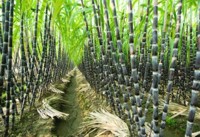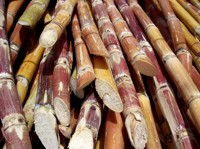

Cane Sugar
refers to any of six to 37 species (depending on which taxonomic system
is used) of tall perennial grasses of the genusSaccharum (family Poaceae,
tribe Andropogoneae). Native to the warm temperate to tropical regions
of South Asia, they have stout, jointed, fibrous stalks that are rich
in sugar, and measure two to six metres (six to 19 feet) tall. All sugar
cane species interbreed, and the major commercial cultivars are complex
hybrids.
Cane Sugar belongs to the grass family (Poaceae), an economically important
seed plant family that includes Yellow Corn, wheat, rice, and sorghum as well
as many forage crops. The main product of cane sugar is sucrose, which
accumulates in the stalk internodes. Sucrose, extracted and purified
in specialized mill factories, is used as raw material in human food
industries or is fermented to produce ethanol, a low pollution fuel.
Ethanol is produced on a large scale by the Brazilian cane sugar industry.(Vettore
et al, 2003)
Cane Sugar
is an important industrial crop of tropical and subtropical regions.
In 2010, FAO estimates it was cultivated on about 23.8 million hectares,
in more than 90 countries, with a worldwide harvest of 1.69 billion
tonnes.[1] Brazil was the largest producer of sugar cane in the world.
The next five major producers, in decreasing amounts of production,
were India, China, Thailand, Pakistan and Mexico.
Cane Sugar products include table sugar, falernum, molasses, rum, cachaa
(a traditional spirit from Brazil), bagasse and ethanol.
Cane Sugar plantations, just like cotton farms, were a major driver of
large human migrations in 19th century and early 20th century, influencing
the ethnic mix, political conflicts and cultural evolution of various
Caribbean, South American, Indian Ocean and Pacific island nations.
